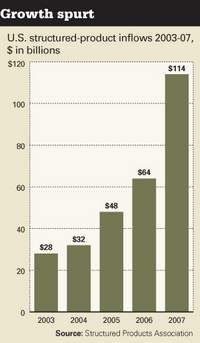By Steve Johnson
Published: July 7 2008 03:00
One of the key selling points of structured products is that, in many cases, they offer risk-averse investors the chance to shield themselves from falling markets.
The capital guarantees embedded in structured products can be absolute, promising the investor all their money back irrespective of the losses suffered by the underlying assets. However, to stand a stronger chance of delivering meaningful returns, more often than not the downside protection is limited - if asset markets suffer particularly sharp falls, the end investor will suffer as well.
For example, equity-linked products may offer capital protection providing an underlying equity market does not fall by more than 50 per cent during the fixed term life of the product.
If this "soft floor" protection barrier is breached, and the market fails to recover during the product term, the investor may end up shouldering losses on a one-for-one basis, just as they would had they entered the market in a traditional, naked, manner.
Some products, such as many of the precipice bonds sold en masse to UK retail investors in the early years of the millennium, had an even nastier trick in the smallprint.
When these soft barriers were breached, as they were in many cases, investors often lost money on a leveraged two-for-one basis - losing up to 80 per cent of their investment in some cases.
The industry has cleaned up its act since then, and few reputable issuers would market such leveraged downside products to retail investors, certainly not without adequate risk warnings.
But despite this episode, the provision of downside protection is a crucial selling point for the structured products industry, particularly when investors are cautious, as they are at present.
For the full article from Financial Times, click here.
Monday, July 7, 2008
Subscribe to:
Post Comments (Atom)




No comments:
Post a Comment